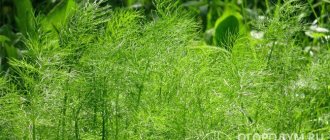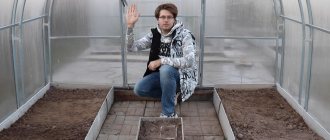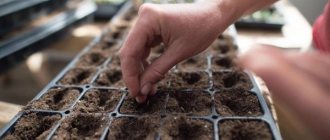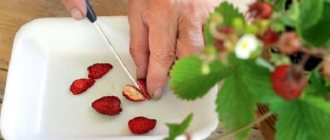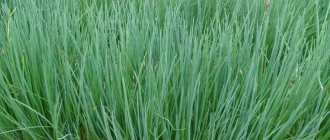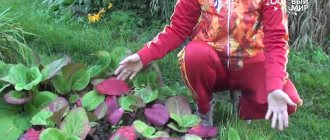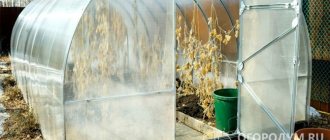Dill is a spicy green crop. It is cultivated both on industrial plantations and in garden plots. It is indispensable for canning, for preparing fresh snacks and salads, it is well stored in the freezer, and does not lose its properties during the drying process. Dill seed extract is used in medicine; preparations with dill and its close relative, fennel, relieve intestinal colic even in infants.
Planting dill seeds is not difficult; it is much more difficult to choose a place and prepare loose, fertile soil. This annual herbaceous plant comes from the arid regions of Asia, where it grows under the scorching sun and often in the absence of moisture.
Optimal planting dates
Dill tolerates cold well, so I start seeding as soon as the snow melts. They can sit in the ground and wait for the soil to warm up to 3-5 degrees Celsius. If suddenly there is frost after sowing, the crop can withstand up to -6 degrees.
A pleasant temperature for dill is 12-15 degrees. Then he grows unhindered. A temperature of 20 degrees is the most optimal.
If you trust the lunar calendar, pay attention to the most favorable days for sowing:
- in May - from the 5th to the 8th;
- in June - from the 4th to the 6th.
It is not advisable to plant when the moon is just entering its initial phase and the full moon.
Recommendation
To get fresh herbs every two to three weeks, I sow dill in several passes, with an interval of 2 weeks.
What conditions are needed for growing?
For dill, the type of soil does not really matter. It does equally well in sandy and loamy soils. However, the seeds are poorly fixed and difficult to germinate on infertile sandy soils. Light and medium loams are most suitable. Soil acidity also matters. Dill does not grow well at a pH below 6.3.
To obtain good quality greens, plants need regular watering and fertilizing with mineral fertilizers. Seeds and young plants tolerate frosts down to -3...-5o C. This feature of dill makes it possible to do winter sowings.
Important! To keep plants from getting sick, they need a lot of sunlight and warmth.
The optimal air temperature for green growth is at an average daily temperature of 16-20o C.
How to prepare seeds
To begin, I soak the seeds in water for several days. It is necessary to wash the essential oils from the grains so that the plant sprouts faster. The same technique is used when planting carrots. I will give step-by-step instructions on how to do this.
- I pour the seeds with very warm water, about 50 degrees. The water immediately turns yellow.
- I change the water up to 5 times a day. If possible, I make sure that the water does not cool down; each time it becomes lighter, as the essential oils are washed out.
- On the third day, I spread the seeds on gauze folded in several layers and dry them slightly.
That's it, the seeds are ready for planting - let's go to the garden bed.
By the way, there is another way to prepare seeds, called bubbling. This is when essential oils are washed out by air currents in the water using an aquarium compressor. In this case, it is also necessary to change the water 4-6 times during the day.
Material selection
Where to get?
Planting material of various varieties of dill can be purchased in specialized stores or ordered online. When purchasing, you should pay attention to the characteristics of the variety - recommended sowing time, yield, purpose. The price of seeds varies depending on the variety :
- in Moscow from 40 to 150 rubles per package;
- in St. Petersburg - from 30 to 120 rubles.
How to prepare?
- Wrap the seeds in gauze and soak for three days in water at a temperature of approximately +45 degrees. Settled water should be drained up to five times a day. This technique will help disinfect the seeds and speed up germination.
- After treatment with hot water, place the seeds on the same gauze and cover with pieces of damp cloth. Leave for four days at a temperature of +20. You need to wait until the sprouts appear.
- Dry the seeds before sowing.
Such preparation will allow you to get the first green seedlings in 4-6 days. Shoots of untreated seeds will appear only after 2-3 weeks . Pre-planting treatment also increases the plant’s immunity and ensures seed disinfection.
Soil preparation
Dill loves a lot of light and moist soil. Therefore, we choose the right place for the garden bed.
Important
Experienced agronomists have noticed that crops that grow in shaded areas absorb nitrates more strongly.
It will be better if in the fall we choose a place where we will plant the seeds and prepare the soil, then we can limit ourselves to simply loosening. Then we cut grooves 1-2 cm deep, pour water on them, sow the seeds, dig in with earth and tamp lightly with our hands.
If we maintain a distance of 1-2 cm between the seeds, we will get powerful bushes with lush greenery.
You should not water what has just been planted, otherwise the water will carry the seeds with it into the depths of the soil and then the sprouts will have to wait longer than usual.
If you cannot visit the site often, cover the bed with film and secure it with something heavy. Now neither the wind nor the birds are afraid of the seeds. But as soon as they germinate, we remove the shelter.
Important
The film will not protect against high temperatures. The plants underneath will burn. Therefore, it is best to cover it with spunbond.
Sowing before winter
To obtain early harvests, uninterrupted and maximum yield of greenery, it is more expedient and correct to plant dill in late autumn, before winter. The optimal timing of winter sowing is determined by weather conditions in the region: in the south it is usually carried out in the first half of November, in the middle zone and further north - in October. The material should be pre-disinfected to prevent fungal diseases and dried. After disinfection, there is no need to rinse or soak it in stimulants. On the contrary, trying to prevent swelling and germination, clear, frosty days (without rain) are chosen for sowing.
Dry seeds are simply scattered on the surface of frozen soil
Seeds are consumed with some reserve, taking into account the non-viability of part of the seed, the possible death of awakened sprouts due to temperature changes, accidental burial, and washing out by spring waters.
In regions with a predominance of strong winds and snowless winters, the sowing site is covered with perforated film or agrofibre to protect against weathering and seed eating by birds. The cover is removed after the snow melts in the spring.
Seeds that have undergone natural stratification by frost, being in the ground saturated with snow moisture, germinate independently in the allotted time, despite the cool temperature of the surrounding air.
What does the appearance of greenery say?
By the appearance of the greenery and how it gains growth, you can understand whether everything is fine with our plant. For example:
- if the dill turns yellow, it means there is not enough nitrogen, which is contained in urea or mullein, and it may also be cold or lacking space;
- if it quickly fades into color, it means there is little moisture;
- slow growth indicates lack of nutrients or low temperature;
- red color indicates that the soil is too acidic or has a lot of potassium.
Where should you sow to get a good harvest?
You need to choose a sunny place for planting dill seeds . A sufficient amount of light will ensure healthy development and juiciness of plants. Shaded bushes stretch out, have a pale color and lose some of their beneficial properties.
The soil should be neutral and loose. Dill growing in acidic soil acquires a reddish tint, and in alkaline soil it becomes yellow. In both cases, the plant develops slowly, delaying the ability to harvest herbs.
You cannot sow dill in areas where water often stagnates or where groundwater comes close to the surface.
How to care after planting
Now that the young greens have started to grow, you won’t need any special care. The main thing is not to let the soil dry out, but also not to overwater it, so that powdery mildew does not appear.
When very hot days set in, the plant likes rain watering. I do this from a watering can.
While the plant is young, it is important to remove weeds. When it gets stronger, they will no longer be afraid of it.
Did you know that dill also needs to be pinched? If you pinch the umbrella in time, a new sprout will appear and there will be much more greenery.
Watch a video on how to properly grow greens so that you can have enough for the whole season.
Features of caring for and growing dill in open ground
After the seedlings sprout in the garden bed, you should immediately remove the covering material (agrofibre or film) that you laid down immediately after planting.
Watering is the most important component of proper dill care. The soil in the garden should always be moderately moist. You should not allow it to dry out completely or “fill it” with water (these two extremes will have a bad effect on the greenery and condition of the plants). With a lack of moisture, greens grow coarser and smaller.
Advice! In hot and dry weather, it is useful to water the greens using the sprinkling method.
As for fertilizing, it should not be done. The greenery will grow and develop beautifully even without fertilizing (especially if you fertilized the soil before sowing).
Advice! If you want to get more greenery from one plant, then you need to pinch out the umbrella at the moment when it just begins to appear. After this, a new stem will begin to grow from the axil of the leaf.
Dill in open ground can be affected by diseases (powdery mildew) and pests (aphids). To combat such undesirable phenomena, you cannot use chemicals, since greens easily accumulate harmful substances. It is optimal to use biological preparations, for example, the biofungicide Fitosporin against diseases, and Fitoverm or tobacco dust (or some other preparations) against pests.
Approximately 1 month after germination of the seedlings (when the height of the greenery is about 15-20 centimeters), it will be possible to begin harvesting. Cleaning should be done in dry weather. However, you can cut the greens earlier if you wish.
When to harvest dill
The time for cutting dill depends on its timing and purpose. Early varieties are ready to produce the first greens from the garden in 33-35 days. After this they begin the flowering phase. Spicy umbrellas are left for seeds. They are indispensable for preserving cucumbers, zucchini and tomatoes. The seeds are collected for planting, as well as for use in cooking and medicinal purposes. The stems of the plant are pulled out by the roots; the annual crop will not sprout next year.
Advice. Ripe fruits fall off easily, so they are collected in advance and dried in the shade. To avoid losing the seeds, put paper bags on the umbrellas.
Mid-season varieties “Kibray”, “Richelieu”, “Abundant Leaved”, “Borey” are universal crops. The bush form of plants allows you to collect green leaves in large quantities and over a long period. Cutting begins a week later than early dill. By this time, the rosette has grown to 15-25 cm. The leaves are collected starting from the lower ones. It is better to cut off the lateral petioles without affecting the growth points from which new leaves will appear. It is recommended to choose cool weather for harvesting greens.
Advice. Leave a few plants for seed. During the season, do not pick off their leaves, then the fruits will be strong and healthy.
How to harvest dill correctly - uproot or cut off the leaves? Ordinary plants immediately give an umbrella, so they are pulled out. Late-ripening bush forms are distinguished by their ability to produce several harvests of leaves. They are carefully cut with sharp scissors. How to collect herbs for spices? It is pulled out of the ground, the roots are cut off, and the stems are tied into sheaves. In this form they dry for a week. Ripe seeds are threshed and stored in a closed container.
Diseases and pests
In the garden, fragrant grass often acts as a natural repellent and protector of other crops, actively attracting pollinators and entomophages. But sometimes dill itself is attacked by insects and suffers from diseases.
Diseases can be triggered by several factors in combination or one of them: severe contamination of the bed with wild herbs, excessive or infrequent watering, thickening. The spice does not grow well on acidic and heavy soils, in the shade. The main care of plantings is to eliminate such situations and correct errors.
If suspicious symptoms occur - unhealthy plaque, mold, rot, drying out, cobwebs, lumps of white foam, deformation of leaves, changes in their color - measures should be taken. But first we need to understand the causes of painful developmental disorders.
The plant is not afraid of cold weather, but, for example, a change in leaf color can occur due to frostbite or a lack of phosphorus and potassium
If earlier outbreaks of powdery mildew, fusarium, alternaria, peronospora, anthracnose, cercospora, and cleasterosporia were noticed in the cultivated area, care should be taken to prevent it. Experienced gardeners advise treating the area in warm weather with biological products (Baktofit, Trichodermin, Fitosporin). In case of severe lesions, it is impossible to do without treating the soil with more serious fungicides.
To clean the soil from pathogenic fungi, it is spilled with a solution of colloidal sulfur and copper oxychloride to a depth of 5-10 cm. Twice treatment with a short interval will be required.
Sick seedlings become a source of infection and create a risk of infecting other vegetables and flowers. Therefore, it is easier to replant dill than to treat it.
Umbrella blinds, cicadas, aphids, psyllids, and striped stink bugs parasitize openwork branches.
The panicles swaying in the wind can drive white butterflies away from cabbage and lettuce, but they do not in the least frighten the anise moth, the carrot fly that lays its larvae on the plant. If a few colonies of pests are detected, it is permissible to spray the foliage with products based on organic components. After using Fitoverm, Entobacterin and similar drugs, you can eat greens within 7 days.
